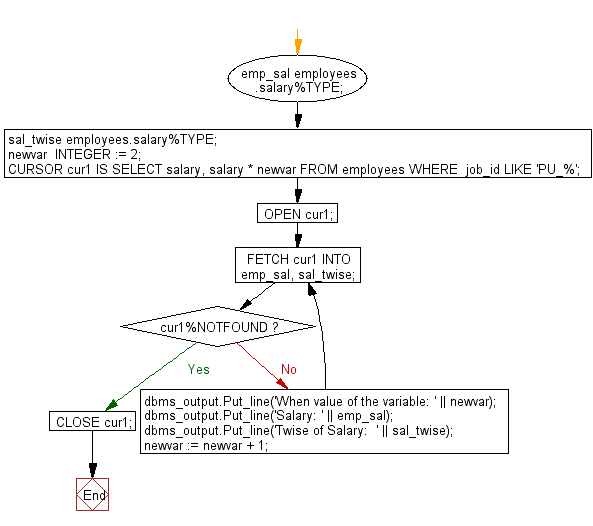PL/SQL Cursor Exercises: Show the uses of a variable in explicit cursor query, and no result set is affected despite that value of the variable is incremented after every fetch
PL/SQL Cursor: Exercise-27 with Solution
Write a PL/SQL block to show the uses of a variable in explicit cursor query, and no result set is affected despite that value of the variable is incremented after every fetch.
Sample Solution:
Table: employees
employee_id integer first_name varchar(25) last_name varchar(25) email archar(25) phone_number varchar(15) hire_date date job_id varchar(25) salary integer commission_pct decimal(5,2) manager_id integer department_id integer
PL/SQL Code:
DECLARE
emp_sal employees.salary%TYPE;
sal_twise employees.salary%TYPE;
newvar INTEGER := 2;
CURSOR cur1 IS
SELECT salary,
salary * newvar
FROM employees
WHERE job_id LIKE 'PU_%';
BEGIN
OPEN cur1;
LOOP
FETCH cur1 INTO emp_sal, sal_twise;
EXIT WHEN cur1%NOTFOUND;
dbms_output.Put_line('When value of the variable: '
|| newvar);
dbms_output.Put_line('Salary: '
|| emp_sal);
dbms_output.Put_line('Twise of Salary: '
|| sal_twise);
newvar := newvar + 1;
END LOOP;
CLOSE cur1;
END;
/
Sample Output:
SQL> / When value of the variable: 2 Salary: 3100 Twise of Salary: 6200 When value of the variable: 3 Salary: 2900 Twise of Salary: 5800 When value of the variable: 4 Salary: 2800 Twise of Salary: 5600 When value of the variable: 5 Salary: 2600 Twise of Salary: 5200 When value of the variable: 6 Salary: 2500 Twise of Salary: 5000 When value of the variable: 7 Salary: 11000 Twise of Salary: 22000 PL/SQL procedure successfully completed.
Flowchart:

Go to:
PREV : Write a program in PL/SQL to fetch the first three rows of a result set into three records using Same explicit cursor into different variables.
NEXT : Write a PL/SQL block to display department name, head of the department,city, and employee with highest salary.
Improve this sample solution and post your code through Disqus
What is the difficulty level of this exercise?
